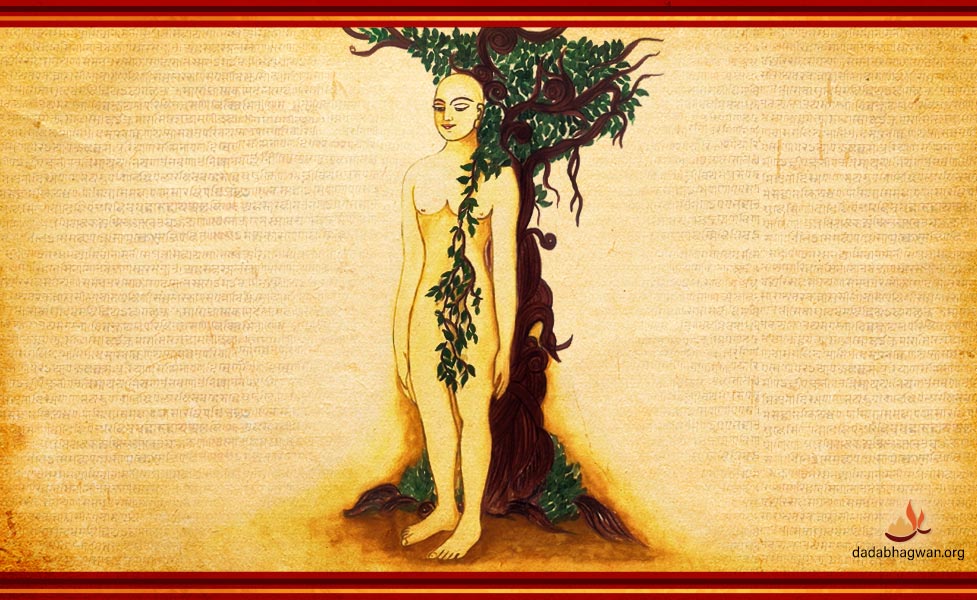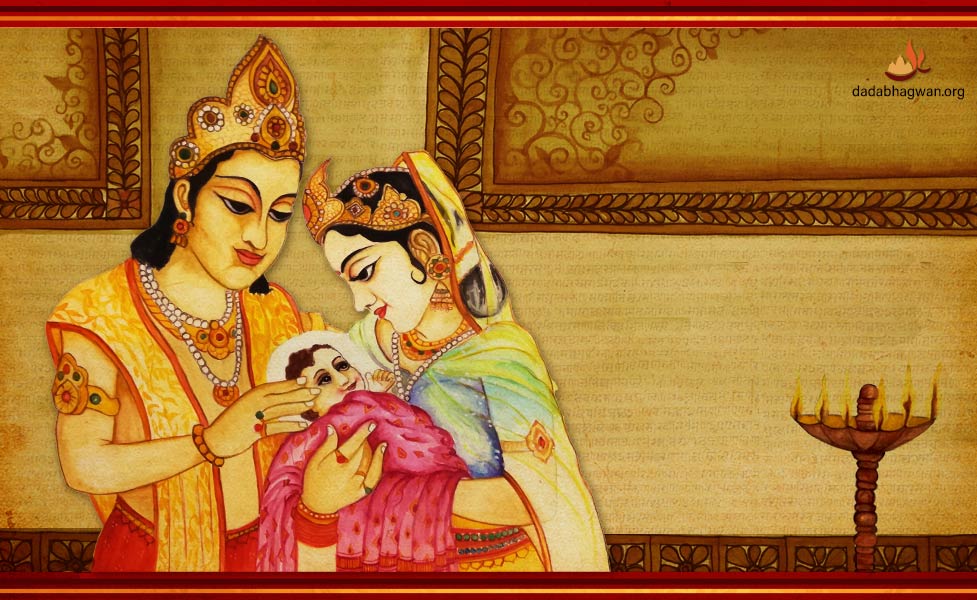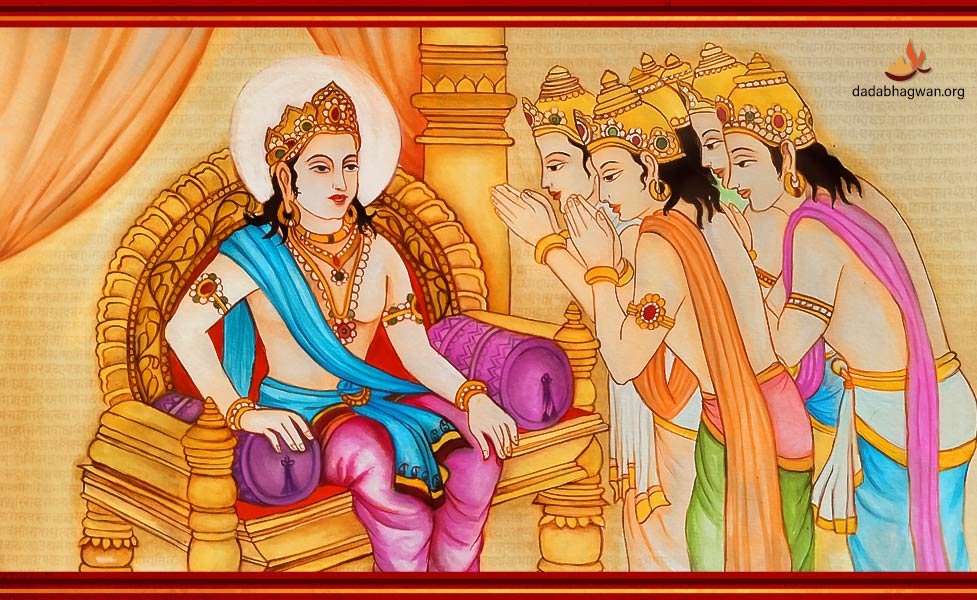Shree Dharmanath Bhagwan: Life Stories of the Fifteenth Tirthankara
Recognized by the vajra (thunderbolt) laanchan (symbol), Dharmanath Bhagwan is the 15th Tirthankara of this current time cycle. Born in the Ratnapur city, He was the son of King Bhanu and Queen Suvrata Devi. His height measured 45 bows. After a long span of life, He took Diksha and attained Nirvana. Kinnar Yaksh Dev and Kandarpa Yakshini Devi are His Shaasan Dev and Shaasan Devi, respectively.

Let’s now go through the life stories of the Lord’s past two births, prior to His birth as Tirthankara. Finally, we will go through His final birth story.
The Third Last Birth as King Dridhrath and Second Last Birth in Heaven
Lord Dharmanath, in His third-last birth, was born as a King named Dridhrath in the city of Bhaddil in Bharat Vijay located in the region of Mahavideh Kshetra in Ghatki Khand. He was a pious King who ruled his kingdom with purity. Distinctly, he ruled with detachment just as a guest in his own home.
Even Param Pujya Dada Bhagwan, the spiritual scientist of the Akram path to liberation, used to live like a guest in His own home. Does a guest have any tension or need to do anything? Does the guest even have to interfere into anything? No, right? The other members of the home, as the hosts, keep everything, ranging right from towel to food, ready for the guest, right? Thus, He used to say to live like a guest at home.
Similarly, King Dridhrath ran his kingdom like a guest. After some time of ruling the kingdom, he took Diksha and profoundly worshipped and sang praises of the Tirthankaras. As a result, he gained the Tirthankara-naam-gotra-karma. After completing his lifespan, he took birth as a celestial being in the Vijayant Anuttar heaven. Here, he had a very long lifespan.
The Last Birth as a Tirthankara Bhagwan Dharmanath Swami

After completing the lifespan as a celestial being, the Soul of King Dridhrath descended into the womb of Queen Suvrata Devi who was the wife of King Bhanu of Ratnapur city in Bharat Kshetra. When this Soul was in the womb, the Queen was much active in religious activities and many religious desires were occurring from within. Due to the increased inclination towards religion, the parents named their son as Dharmanath.
The son had a golden complexion. His childhood was spent in learning the diverse types of eruditions. In His youth, He got married and was coronated as the King.

Upon the request of a few celestial beings, King Dharmanath took Diksha. After two years of taking Diksha, He attained Keval-Gnan (omniscience, absolute knowledge). After Keval-Gnan, the celestial beings arranged a Samavasaran wherein He presided to give insightful Deshna. Thousands of people of different villages used to come to listen to the Deshna of the Tirthankara Bhagwan, which was not only blissful but also liberating.
Even the fifth Vasudev of this time cycle, Purush Sinh and Sudarshan Baldev attended the Samavasaran of Lord Dharmanth. After listening to His Deshna, Purush Sinh experienced complete vairagya and consequently attained Samkit (the right vision through Self-realization). Sudarshan took up the Shravak Dharma and attained Moksha.
The Deshna of a Tirthankar Bhagwan is such that it cuts the veils of anger (krodh), pride (maan), deceit and greed or lobh (4 kashays); stabilizes the wandering mind, chit, intellect and ego; and triggers the attainment of samkit. Lord Dharmanath gave a matchlessly insightful Deshna on kashay.
Comprehending Kashays
For those who want to attain the ultimate liberation, it is indispensable to either realize the Soul or become devoid of kashays. Deceit and greed go into Raag (attachment), while anger and pride go into Dwesh (abhorrence). If the ignorance of the Self goes away (through Self-realization), both attachment and abhorrence go away, and thus, the kashays go away.
So, how kashays originate? When jad (the parmanus; the subtlest and indivisible sub-atomic particles) and chetan (Soul) come near, their mixture gives rise to the third entity. This is similar to obtaining a third item (such as rose gold) by mixing copper and gold. The third entity that seems to appear from the mixture of jad and chetan is called aham or egoism.
Due to the mixture form (not compound form), the egoism believes that the properties and actions of jad are mine and even the properties of Soul such as infinite knowledge, infinite vision and infinite bliss are mine. It also consequently believes that I am the doer of the actions, which are really taking place in jad. As a result, the egoism becomes the doer. It is called mishrachetan, meaning “I” with the erroneous belief due to the mixture of the Self and the non-Self.
To get devoid of kashays, it is indispensable to ask for forgiveness, repent heartily for the kashay done and make a firm resolution of not repeating it again. This is a three-step process called Pratikraman, which should be done instantly once any kashay happens. It makes one feel lighter and releases from the bondage of kashays. Kashays make us dependent on the non-Self, while pratikraman is the result of being dependent on the Self. Pratikraman is the real spiritual effort, the effort that requires no outside evidence and makes one progress as the Self.
With sincere pratikramans done for each kashay whenever it arises, one can cross the following sub-categories of kashays, each varying in severity:
- Anantanubandhi Kashays: These kashays are the most intense ones and are irreversible in the state of ignorance. They are as obstinate as horns. They also obstruct Self-realization. For example, if the father gets severely angry with the son and says, “I will not see your face now. Please go away. Do not come to my home,” it is called terrible anger. This breaks the mind of both the son and the father and triggers separation that remains for lifetime. This is anantanubandhi anger. Such anger binds the father’s Soul for infinite worldly lifetimes. There is no awareness as to what the fruit of this anantanubandhi anger will be. In the ignorance state, this is what humans tend to do.
- Apratyakhyani Kashays: These kashays are like solid rubbers that become soft upon pressing, indicating that they are less obstinate than anantanubandhi kashays. For example, if now the father repents, then this anantanubandhi karma becomes lighter and transforms into apratyakhyani kashay. However, for this transition to happen, pratikraman should happen heartily within a year of getting angry. If done heartily, the father will not remember at all that such fault was done. If this happens, that layer of anantanubandhi anger goes away. Apratyakhyani kashays are the faults of anger, pride, deceit and greed for which resolving of not to do it again is to be done.
- Pratyakhyani Kashays: These kashays are like rubber strings that wrap or fold easily without effort, meaning one can easily control them. In the case of an apratyakhani kashay, the person realizes the fault and does heartfelt pratikraman within 15 days of its occurrence. If this happens, the apratyakhani kashay becomes pratyakhani kashay. Pratyakhyani kashays are the faults of anger, pride, deceit and greed for which resolution of never to repeat them is going on thoroughly.
- Sanjvalan Kashays: These kashays are mild and are easily reversible. They are as soft as cotton and do not stay for long. Their presence indicates that pratyakhyani kashays are over. They tend to shed instantly, within less than the fraction of a second. With only these kashays left to be removed, one is near Keval Gnan.
This is how pratikraman helps not only in reducing the intensity or severity of kashays but also in getting devoid of them. It is because of the kashays that the karmas are bound. They are in the form of causes. Soul is there where there is absence of kashays. As long as there are kashays, the realization of the absolute Self (Soul) is not possible.
- Mithyatva: Here, the individual does not know anything about Soul or Atma but is aware of the fact that it is indispensable to worship Tirthankaras for attaining Moksha. If this understanding does not arise, one is said to be completely ignorant; one is living in complete darkness. From this stage, one directly reaches the fourth gunsthanak.
- Saswadan: One does not reach the second stage while rising but comes here only while falling from the 11th stage to the 1st one. It is a stage to pass by.
- Mishra Mohaniya: One does not reach the third stage while rising but comes here only while falling from the 11th stage to the 1st one. In this stage, one fluctuates between the wrong belief and the right belief.
- Avirati Samyakdrashti: One reaches this stage directly from the first stage. Here, the stage of being a Samkit starts and the anantanubandhi kashays completely go away.
- Deshvirti: This stage marks the presence of apratyakhyani kashays. Now, one starts taking pratyakhyans (resolutions) and reaches the next stage.
- Sarvavirti or Pramatta: This stage marks the presence of pratyakhyani kashays, meaning the faults of anger, pride, deceit, and greed for which pratyakhyan is ongoing. Here, these faults or kashays keep occurring despite doing pratikraman and pratyakhyan. This is because not all layers of each of those faults have gone away. These are the layers for which pratikraman and pratyakhyan, although done, are not exactly done in a systematic way. When pratikraman and pratyakhyan are done for each manifesting layer of fault, that many layers shed away. The veils that remain due to the need to continue pratyakhyan, also known as pratyakhyan aavrano, shed off when all causes of each manifesting layer of fault are seen with the knowledge of the Self attained through Self-realization. This is the stage of sarva virti, meaning total cessation of worldly intents. Once pratyakhyan aavrano (veils) go away, only sanjvalan kashays remain.
- Apramatt: : In this stage, one is able to remove the kashays in just an hour or maximum within 15 days.
- Apurvakaran (Nivritti-Badar): Apurva karan means never seen before. It is the stage marked by great joy. At this stage, one breaks the tuber of subtle lust or sex. Although gross sensual pleasures stop from the sixth stage, its subtle tuber still exists. Once it is completely eradicated, one crosses the next stage, the 9th stage called Anivritti-Badar, and reaches the 10th stage directly.
- Anivritti-Badar: This is where one is free from all sensual pleasures; there is no single parmanu of these pleasures, not a single thought comes, and no attraction occurs at all.
- Nivritti-Badar: This is where subtle greed exists.
- Upashant Moh: This is where the subtlest greed exists. It seems that there is no greed at all but it is not so; greed has been suppressed. Because of the supressed greed, one misunderstands to become God. As a result of this false belief, one falls down directly to the first gunsthanak. This is bound to happen for most people. This is why the Gnanis directly jump to the 12th gunsthanak.
- Kshina Moh: This is the stage where all kashays have weakened, giving the experience of the sanjvalan state. When sanjvalan is over, one moves to the next stage.
- Sayogi Kevali: This is the stage wherein Keval Gnan occurs.
- Ayogi Kevali: This stage lasts for the subtlest part of time in which one attains Moksha. The Soul is liberated forever from this world and remains in its pure state in Siddhashila, physically occurring at the top of this Universe.
Nirvana
Finally, coming back to Dharmanath Bhagwan, He had 43 Gandharas (chief disciples of the Tirthankara). He also had lakhs of Sadhus, Sadhvis, Shravaks and Shravikas all of whom attained Gnan and got liberated forever from the cycle of birth and death. Along with 108 munis, He attained Nirvana from the Sammed Shikharji Mountain.
This is how a Tirthankara becomes the supreme medium (nimit) in liberating crores of people.
subscribe your email for our latest news and events





